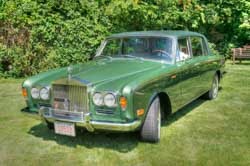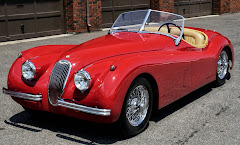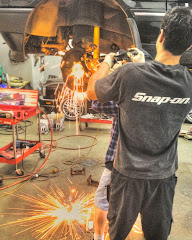Maintaining an older car like an airplane - can it be done? I think so.
 |
| The famous 1962 Buick Invicta - photo by John Elder Robison |
The problem with the factory maintenance schedules for most
modern cars is that they are designed for a finite lifespan, typically 4-6
years or 50-100,000 miles. The
manufacturer-provided schedules all end at that point, and it’s assumed people will make their own decisions from there to the point where the car is scrapped.
In addition, some manufacturer schedules minimize costly
service activities in the first four years – knowing there will be a high cost
for that later on – in order to present a “low cost of ownership” to the first
operator of the car, who typically keeps it 3 to 4 years. That’s not a very constructive approach for someone who
wants to keep his car in near-new functional condition for 30 years.
I suggest that the car-enthusiast world can learn something
about long-term preventative care from the commercial aviation people who keep jet aircraft at or near as-built
levels of performance and reliability for several decades. They do this with rigorous inspection,
combined with time and running-hour based overhauls and replacements.
 |
| This Air Force C5B is 28 years old, with no plans for retiring anytime soon - John Elder Robison photo |
What are some of the changes we might make to a factory
schedule, if we wanted indefinite lifespan?
Here are some areas we may consider but this list is by no means complete:
First of all, EVERY fluid should have a reasonable change
interval. Contrary to what some
carmakers tell us, there is no such thing as a permanent fluid in a car. For
some fluids we might use a test/time basis. That can be done easily for
coolant and brake fluid, where we use test strips to measure ph or water
absorption. Both might be changed at 4
or 4 years, or when the test strip shows a marginal reading, whichever comes
first.
For other fluids, like those in power hydraulic systems or
driveline components we must make a schedule based on our best judgment, which
may differ from car to car.
 |
| With proper care, this Mercedes can last as long as its owner. Robison Service photo |
When a car is new it's easy to treat bare metal in exposed areas, and thereby reduce the chances of corrosion related problems years later. Modern car's don't generally need what we used to call undercoating but treatment of suspension hardware and other bare parts will pay big dividends when those parts need to be dismantled for service later on. Anyone who has cut suspension arms off a later model car because the hardware is rusted solid knows what I mean.
Rubber hoses of all kinds, and belts of all kinds should be on a replacement schedule. This would include vacuum hose, AC line, coolant hose, and hydraulic, fuel and brake hoses. Depending on the application, 7-12 years is probably the range at which these should be changed with some types of hoses lasting longer than others.
Rubber hoses of all kinds, and belts of all kinds should be on a replacement schedule. This would include vacuum hose, AC line, coolant hose, and hydraulic, fuel and brake hoses. Depending on the application, 7-12 years is probably the range at which these should be changed with some types of hoses lasting longer than others.
When hoses are replaced, clamps and seals should be renewed
at the same time. When belts are
replaced idler rollers should be renewed too.
Whenever belts are changed, a leak and damage inspection should be
performed.
Fuel pumps, coolant pumps, and cooling fans should be on a
combination time/miles schedule. Thermostats
are another item whose replacement can be scheduled. Relays have a finite
lifespan based on age and operating cycles and they should be scheduled for
periodic change too.
 |
| Relays age invisibly and fail without warning. Replace them to avoid problems |
Airplanes are designed to be re-powered without compromising
reliability in areas other than the engine (which is clearly improved). Cars – unfortunately – are not designed the
same way. Removal of a car engine
involves disconnecting and reconnecting many fasteners and connectors whose
lifespan is limited, and whose access is poor.
Removal of a car engine may compromise a radiator or a hundred other
things, and you get into a cascading situation when trying to service one major
component. Aircraft engines – in
contrast – are on pylons where all the service connections are in one spot, designed
for periodic removal. Given this
situation, it’s unclear if long-term reliability is improved by scheduled
overhaul of a car’s engine or major driveline components.
Then we have the suspension.
We know that bushings deteriorate, as do shocks and struts. Scheduled overhaul of suspensions is a good
way to keep the car feeling and handling as new. The mileage at which this is done will vary
from one car line to another, and there may be large enough differences in
component lifespans that this job is staggered over several service intervals.
Brakes can certainly be serviced with a similar
philosophy. Master cylinders and
boosters can be replaced periodically (perhaps at a 10-year interval) and
calipers and wheel components can be overhauled (probably more often) Pads and rotors are already part of factory
schedules.
 |
| Brake and strut service on a Porsche - at Robison Service |
When a car is not driven a lot of miles the tires are often
ignored. "There's hardly any tread wear," people say, so the tires must still be good even if they are old. Wrong! Tires come apart inside as the rubber oxidizes and ages. That's why they have date
codes - so we can use those codes to identify and replace aged tires prior to
failure. 7-12 years is a suggested range
for low mileage tire life, depending on application and environment. Worn or damaged tires must be replaced sooner.
 |
| Reading tire date codes - this tire was made in week 04 of 2009 |
A rigorous and regular inspection program is needed to
identify leaks, corrosion, fractures, and the like. Such a program would pick up broken exhaust
hangers, broken motor mounts, and other potential sources of failure to
proceed. This inspection should probably
be done at varying levels of thoroughness at several intervals.
For newer cars, there should be a regular time where
software is checked for updates and all systems are scanned for faults, with
problems addressed as needed. Electrical
systems should be checked for potential problems in the cabling (corrosion or
loose connections) and batteries tested and replaced when test results drop
below a threshold or the battery reaches 4 or perhaps 5 years age. Alternators and possibly starters can be
changed on a time/miles schedule which will depend on reliability in that
particular car line.
 |
| Checking software in a Range Rover - at Robison Service |
Once a particular car line has been in production for 4-5
years a review can be conducted and major issues listed. Armed with that list, the model-specific
weaknesses may be woven into the long-term maintenance plan to improve
reliability going forward.
As the car gets older there will come a point where cosmetic restoration of mechanical parts becomes a normal part of the repair/overhaul process. Prior to that, I recommend that all parts associated with a service be cleaned and cared for as required because that will be the only time many areas of the car receive any such service and the finishes will last longer if they get a modicum of care too.
Finally, the annual inspection should identify and correct
any non-critical wear or failure – damage to paint or trim, problems with
accessories, and visible signs of wear.
We can also learn from Deming’s Quality Management
philosophy and make changes to the service environment in order to do a better
job performing and planning our maintenance. A good TQM
system would continually revise and update a plan like I have outlined to
improve reliability while lowering cost by fine-tuning the program. That, however,
is the subject of another essay.
Some cars are just transportation. Others are special, and we want them to live
forever. For the ones we want to keep,
a plan like the one described above will maximize your chances of success. The cost of this approach may seem high at times, but if done properly the huge (potentially mid six figure) costs of thorough mechanical and cosmetic restoration may be avoided or dramatically reduced. If one person owns the car the whole time, his costs are very likely to be less in total.
The list above is by no means complete. I welcome suggestions for improving this
system of long-term automobile preservation, and I encourage anyone who wants
to keep a car forever to adopt this or a similar plan.
John Elder Robison is the general manager of J E Robison Service, independent restoration and service for Bentley, Rolls Royce, Land Rover, and other fine motorcars in Springfield, MA Find him online at www.robisonservice.com or on the phone at 413-785-1665


























No comments:
Post a Comment